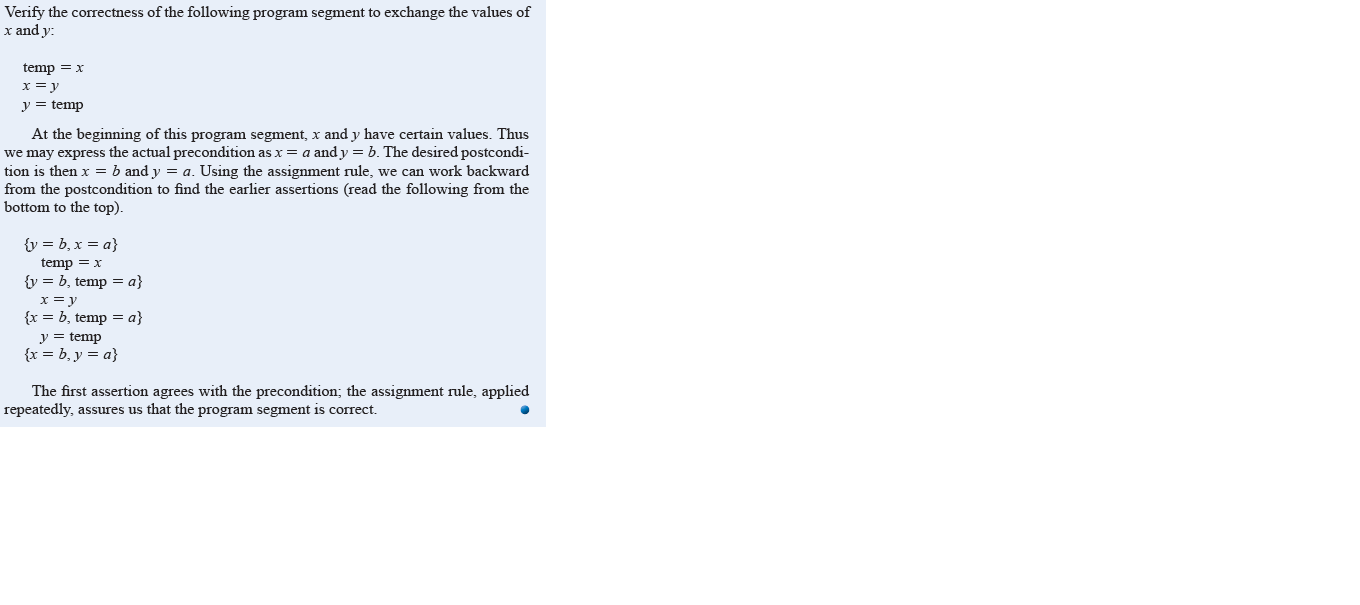
Database System Concepts
7th Edition
ISBN: 9780078022159
Author: Abraham Silberschatz Professor, Henry F. Korth, S. Sudarshan
Publisher: McGraw-Hill Education
expand_more
expand_more
format_list_bulleted
Question

Transcribed Image Text:Verify the correctness of the following program segment to exchange the values of
x and y:
temp = x
y = temp
At the beginning of this program segment, x and y have certain values. Thus
we may express the actual precondition as x = a and y = b. The desired postcondi-
tion is then x = b and y = a. Using the assignment rule, we can work backward
from the postcondition to find the earlier assertions (read the following from the
bottom to the top).
{y = b, x = a}
temp = x
{y = b, temp = a}
{x = b, temp = a}
y = temp
{x = b, y = a}
The first assertion agrees with the precondition; the assignment rule, applied
repeatedly, assures us that the program segment is correct.
Expert Solution
This question has been solved!
Explore an expertly crafted, step-by-step solution for a thorough understanding of key concepts.
This is a popular solution
Trending nowThis is a popular solution!
Step by stepSolved in 2 steps with 1 images

Knowledge Booster
Similar questions
- The two most recent operands are popped in the postfix expression evaluation example whenever an operator is met so that the subexpression may be evaluated. In the subexpression, the first operand popped is regarded as the second operand, and the second operand popped as the first. Give a case study that exemplifies the significance of this component of the solution.arrow_forwardUse DrRacket. Define the procedures below. Write a procedure reverse-digits (n) which returns a number with the digits of n in reverse order. For example, (reverse-digits 397164) → 461793. Define a predicate same-digits? (a b) which returns #t if the integers a and b contain the same digits. If a digit occurs n times in a, it must also occur n times in b. For example, (same-digits? 133042 420313) → #t, but (same-digits? 133042 42013) → #f. To solve the problem, one technique would be to add some extra procedures for manipulating digits inside a number. Here are some hints: To find the number of digits in a number, count how many times you need to divide it by 10 until you reach 0. To extract the second digit of 5784: floor( 5784/102 ) mod 10=7. Note that mod in racket is modulo or remainder To assemble the digits 3, 4, and 5 into a number: 3×102+4×101+5×100 = 345 The standard Scheme procedures modulo and floor may prove useful. The solution only needs to consider non-negative…arrow_forwardThe following argument is valid. ((A ∨ D) → W) (R ↔ (C ∧ T)) (← R → A) ← (B ∨ C) ∴ ← (W → C) Below is a natural deduction proof, but with some of the lines and justifications missing. Using any of the proof rules (from Ch. 16 & 18 of the text) in the natural deduction system, fill in the missing lines and justifications to complete the proof (3 points). 1 ((A ∨ D) → W) Pr. 2 (R ↔ (C ∧ T)) Pr. 3 (- R → A) Pr. 4 -(B ∨ C) Pr. /∴← (W → C) 5 (- B ∧ - C) _________ 6 (W → C) _________ 7 _________ ∧E, 5 8 - W MT, 6, 7 9 - (A ∨ D) _________ 10 _________ DM, 9 11 - A ∧E, 10 12 _________ MT, 4 13 R _________ 14 (C ∧ T) _________ 15 C ∧E, 14 16 _________ -E, 7, 15 17 - (W → C) _________arrow_forward
- I need the answer as soon as possiblearrow_forwardHow to solve this question using pythons codearrow_forwardWrite a recursive function, numMoves(), that takes a number representing the number of disks in the Hanoi problem, and returns the number of moves involved. I recommend you start writing this function by modifying the hanoi.py program given. Test cases: numMoves(3) should return 7 and numMoves(4) should return 15. Do not use any global variables. hanoi.pyarrow_forward
arrow_back_ios
arrow_forward_ios
Recommended textbooks for you
 Database System ConceptsComputer ScienceISBN:9780078022159Author:Abraham Silberschatz Professor, Henry F. Korth, S. SudarshanPublisher:McGraw-Hill Education
Database System ConceptsComputer ScienceISBN:9780078022159Author:Abraham Silberschatz Professor, Henry F. Korth, S. SudarshanPublisher:McGraw-Hill Education Starting Out with Python (4th Edition)Computer ScienceISBN:9780134444321Author:Tony GaddisPublisher:PEARSON
Starting Out with Python (4th Edition)Computer ScienceISBN:9780134444321Author:Tony GaddisPublisher:PEARSON Digital Fundamentals (11th Edition)Computer ScienceISBN:9780132737968Author:Thomas L. FloydPublisher:PEARSON
Digital Fundamentals (11th Edition)Computer ScienceISBN:9780132737968Author:Thomas L. FloydPublisher:PEARSON C How to Program (8th Edition)Computer ScienceISBN:9780133976892Author:Paul J. Deitel, Harvey DeitelPublisher:PEARSON
C How to Program (8th Edition)Computer ScienceISBN:9780133976892Author:Paul J. Deitel, Harvey DeitelPublisher:PEARSON Database Systems: Design, Implementation, & Manag...Computer ScienceISBN:9781337627900Author:Carlos Coronel, Steven MorrisPublisher:Cengage Learning
Database Systems: Design, Implementation, & Manag...Computer ScienceISBN:9781337627900Author:Carlos Coronel, Steven MorrisPublisher:Cengage Learning Programmable Logic ControllersComputer ScienceISBN:9780073373843Author:Frank D. PetruzellaPublisher:McGraw-Hill Education
Programmable Logic ControllersComputer ScienceISBN:9780073373843Author:Frank D. PetruzellaPublisher:McGraw-Hill Education

Database System Concepts
Computer Science
ISBN:9780078022159
Author:Abraham Silberschatz Professor, Henry F. Korth, S. Sudarshan
Publisher:McGraw-Hill Education

Starting Out with Python (4th Edition)
Computer Science
ISBN:9780134444321
Author:Tony Gaddis
Publisher:PEARSON

Digital Fundamentals (11th Edition)
Computer Science
ISBN:9780132737968
Author:Thomas L. Floyd
Publisher:PEARSON

C How to Program (8th Edition)
Computer Science
ISBN:9780133976892
Author:Paul J. Deitel, Harvey Deitel
Publisher:PEARSON

Database Systems: Design, Implementation, & Manag...
Computer Science
ISBN:9781337627900
Author:Carlos Coronel, Steven Morris
Publisher:Cengage Learning

Programmable Logic Controllers
Computer Science
ISBN:9780073373843
Author:Frank D. Petruzella
Publisher:McGraw-Hill Education